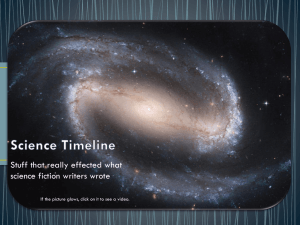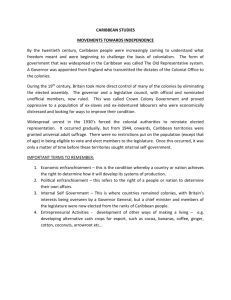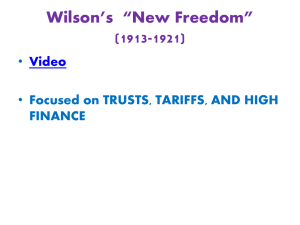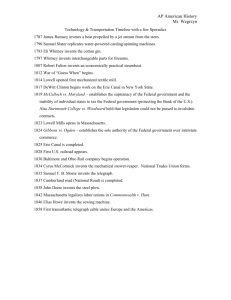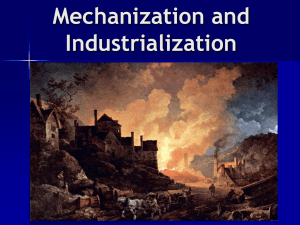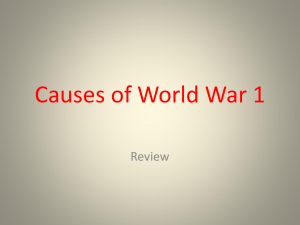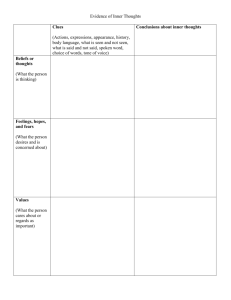CHRONOLOGY OF FACTS NORTH AMERICA 1702 – 1713 King
advertisement
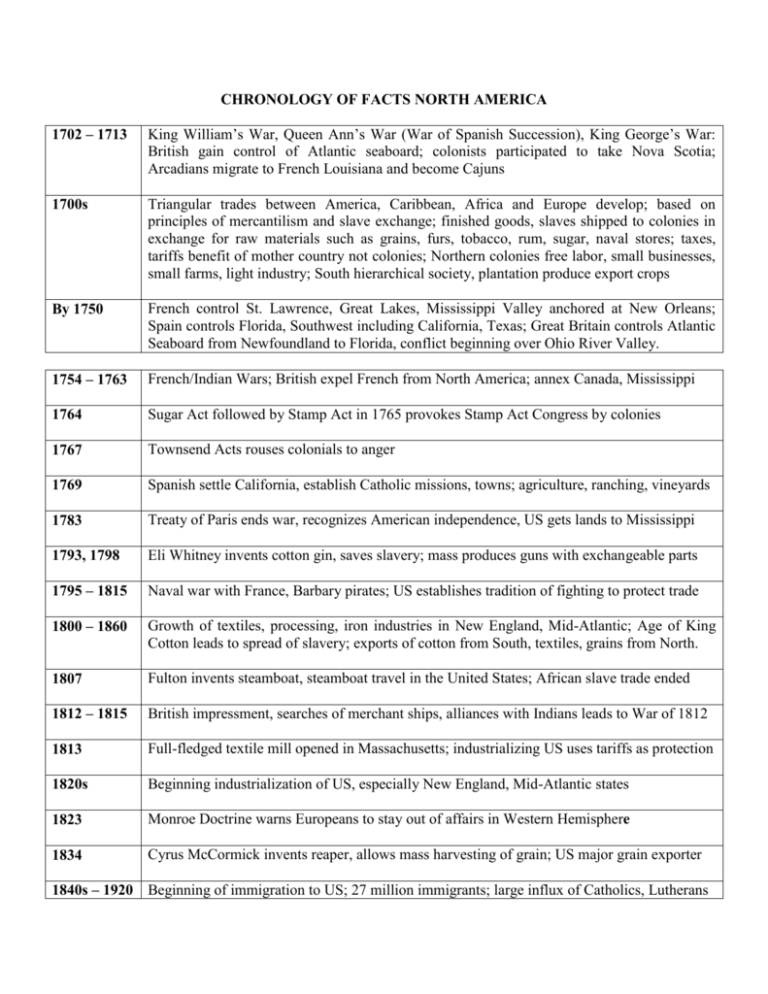
CHRONOLOGY OF FACTS NORTH AMERICA 1702 – 1713 King William’s War, Queen Ann’s War (War of Spanish Succession), King George’s War: British gain control of Atlantic seaboard; colonists participated to take Nova Scotia; Arcadians migrate to French Louisiana and become Cajuns 1700s Triangular trades between America, Caribbean, Africa and Europe develop; based on principles of mercantilism and slave exchange; finished goods, slaves shipped to colonies in exchange for raw materials such as grains, furs, tobacco, rum, sugar, naval stores; taxes, tariffs benefit of mother country not colonies; Northern colonies free labor, small businesses, small farms, light industry; South hierarchical society, plantation produce export crops By 1750 French control St. Lawrence, Great Lakes, Mississippi Valley anchored at New Orleans; Spain controls Florida, Southwest including California, Texas; Great Britain controls Atlantic Seaboard from Newfoundland to Florida, conflict beginning over Ohio River Valley. 1754 – 1763 French/Indian Wars; British expel French from North America; annex Canada, Mississippi 1764 Sugar Act followed by Stamp Act in 1765 provokes Stamp Act Congress by colonies 1767 Townsend Acts rouses colonials to anger 1769 Spanish settle California, establish Catholic missions, towns; agriculture, ranching, vineyards 1783 Treaty of Paris ends war, recognizes American independence, US gets lands to Mississippi 1793, 1798 Eli Whitney invents cotton gin, saves slavery; mass produces guns with exchangeable parts 1795 – 1815 Naval war with France, Barbary pirates; US establishes tradition of fighting to protect trade 1800 – 1860 Growth of textiles, processing, iron industries in New England, Mid-Atlantic; Age of King Cotton leads to spread of slavery; exports of cotton from South, textiles, grains from North. 1807 Fulton invents steamboat, steamboat travel in the United States; African slave trade ended 1812 – 1815 British impressment, searches of merchant ships, alliances with Indians leads to War of 1812 1813 Full-fledged textile mill opened in Massachusetts; industrializing US uses tariffs as protection 1820s Beginning industrialization of US, especially New England, Mid-Atlantic states 1823 Monroe Doctrine warns Europeans to stay out of affairs in Western Hemisphere 1834 Cyrus McCormick invents reaper, allows mass harvesting of grain; US major grain exporter 1840s – 1920 Beginning of immigration to US; 27 million immigrants; large influx of Catholics, Lutherans 1840s American clipper ships to China, US interest there begins; US supports UK in Opium War 1850 Rise of factory system; new national economy, export market; rise of corporations 1854 1870, 1873 Perry and US Navy squadron open up Japan to foreign influence; US signs treaty with Japan Standard Oil (Exxon) founded, oil production spreads; Bethlehem Steel (USS) founded 1876 – 1914 Gilded Age; rise of middle class, growth of industry, massive urbanization in East, Midwest 1870s American exports boom; industry, banks invest in Mexico, Central America, Caribbean\ 1880s Edison invents electric light, later founds General Electric; by 1914 US electronics, steel industries world’s largest; invention of hydraulic elevator, steel lead to rise of skyscrapers 1890 Mahan publishes Influence of Sea Power upon History; US begins building large navy 1890 – 1916 Progressive Era leads to many federal, state, local political, economic, social reforms; US worlds largest steel producer; reformers wage war against political machines, corruption 1898 Spanish American War; US acquires Philippines, Guam, American Samoa, Puerto Rico, Pacific Islands; guerrilla war against Filipino rebels; US annexes Hawaiian islands 1900 US joins international expedition to lift Boxer Siege in Beijing; proposes Open Door Policy 1904 – 1914 Roosevelt Corollary says US will intervene to protect American interests, monetary investments (Dollar Diplomacy); US occupies nations in Caribbean, Central America; 1913 Ford introduces assembly line production in auto industry; ½ of Americans live in cities; urban problems, crime, boss rule, sanitation issues, largely immigrants 1914 Panama Canal opens; US second industrial, manufacturing, finance nation in world; American rural population doubles; American urban population rises 700 percent; World War I begins 1918 US provides foods, manufactures, soldiers; US mobilizes home front, economy, influenza kills 500,000; US intervenes in Russia; Wilson publishes 14 Points, Armistice ends war; US ends war as world’s largest industrial power, exporter, loaning center, food producer 1921 1st transnational air, airmail route; quota laws restrict immigration; US largest merchant fleet 1929 – 1939 Stock Market crash, Great Depression; ⅓ of Americans unemployed; import restrictions rise 1930s Dust Bowl disaster in Midwest, West; great economic, social, political uncertainty 1931 Japan invades Manchuria; US protests, but does little; 3,000 banks close in US; tariffs rise 1932 – 1938 Election of Franklin Roosevelt; New Deal models Keynesian economics including work relief, deficits, rural electrification, banking-stock reform, subsidies, unemployment, social security; unions legalized; minimum wages, 40 hour work week; child labor outlawed 1939 – 1941 World War II begins in Europe; Panama Conference - US, Latin America cooperate in face of outbreak of World War II; US repeals Neutrality Acts of 1935; US gives UK warships; Lend Lease Act eventually loans more than 50 billion to enemies of Axis, Atlantic Charter 1941 – 1945 Pearl Harbor leads to US entry into world war; total war mobilizes entire society, economy; growth of western states, Texas due to war effort; Battles of Midway, Normandy 1945 Conferences: Yalta, Potsdam decide new borders, occupation polices, peace treaties; Germany surrenders; US uses atomic bombs, Japan surrenders; occupation of former Axis begins; UN, 1945 – 1970 US dominant economic power; longest period of sustained economic growth in US history 1946 US grants Philippines independence, champions decolonization; IMF, World Bank created 1947 Cold War begins; Truman Doctrine of military aid to contain spread of communism; Marshall Plan to give aid to rebuild war torn Europe, Asia; US military aid greater than economic aid 1950s Population explosion; Baby Boom; introduction of credit card; mechanization of daily life; 75% all Americans finish high school; Age of Rock n’ Roll becomes world phenomenon 1955 – 1973 US involvement in Vietnam begins with advisors, supplies and ends up with US combat troops Late 1950s Eisenhower, Congress create US highway system; rise of domestic, international air travel 1960s Rise of service sector of American economy, technology in workplace; Civil Rights movement of Martin Luther King; women’s liberation movement begins; Population growth slows; population moving west, south; ½ black population live in north; more Americans live in suburbs than urban areas; Sexual Revolution; Drug culture; rise of crime rate 1961 – 1963 Kennedy confronts missile gap, builds ICBMs; promises to go to moon; US-USSR test ban; US opposes Castro regime in Cuba: Bay of Pigs and Cuban Missile Crisis; Berlin Wall crisis; creates Alliance for Progress, Peace Corps to aid poorer nations 1964 – 1969 Johnson’s Great Society legislation establishes welfare state, Medicaid, Medicare, VISTA, National Defense Education Act, Housing/Urban Development; ends immigration quota; massive war time inflation; Civil Rights Act leads to 1965 Voting Rights Act; supports Israel 1969 – 1973 Nixon Presidency; US withdrawal from Vietnam; Watergate Crisis and Investigation 1970s Growth of environmental movement begins with 1964 publication of Carson’s Silent Spring; passing of Clean Air, Clean Water, Endangered Species Acts; Environmental Protection Agency established; pollution, waste, deforestation, overpopulation remain major problems 1970s 1973 Only 4% population work farms; service sector largest part of economy; one million cars produced a year; 4/5s of blacks live in urban areas, vote as block; urban renewal begins Arab-Israeli War leads to OPEC Oil Embargo, Energy Crisis; opposition to Vietnam War ends with US withdrawal from Vietnam 1970s – 80s Economic downturn, stagnation, recession; US trade deficits, deficit spending increase; massive 3rd world debt unlikely to be repaid; Asian, West European economic competition 1975 US-USSR Helsinki Accords guarantees borders, human rights, cultural exchanges, trade 1980s Computers enter workforce, home; Internet; spread of global popular culture; rise of religious fundamentalism in US, Middle East, South Asia; American population increasingly older; in 1986 Japanese average income surpasses American; new immigrants change face of country 1981 – 1989 Reagan supports supply-side economics, reduces government; confronts communism, funds communist opposition in Latin America, Africa, Asia; deploys missiles in Europe; cooperates with Gorbachev, Pope to defuse crises 1990s US actions as part of UN, NATO: 1st Persian Gulf War, Somalia, Bosnia; UN uses economic sanctions; Asian financial crisis leads to world recession; rise of international terrorism 1994 – 1995 Clinton promotes international trade: NAFTA established, helps found WTO 2001 – Bush presidency; 2001 Trade Tower attack, Afghanistan, Iraq invasions; wider war on terror; NATO enlarged to include former Warsaw Pact nations; opposes Global Warming accords
